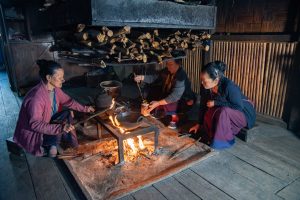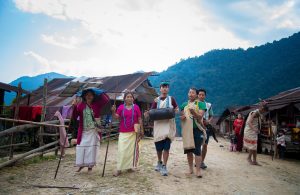Arunachal Pradesh is an indigenous cultural melting pot but many of its heritage could be lost to posterity for lack of preservation. A grant from the U.S. Ambassadors Fund for Cultural Preservation is helping to document and preserve the traditions of indigenous communities, reports Michael Gallant
 For thousands of years, indigenous communities in Arunachal Pradesh have lived in harmony with the natural world. Now, a grant from the U.S. Ambassadors Fund for Cultural Preservation (AFCP) is helping make sure that these communities’ heritage and traditions will remain safe for thousands more. AFCP supports projects to preserve a wide range of cultural heritage, including historic buildings, archaeological sites, paintings, manuscripts, indigenous languages and other forms of traditional cultural expression.
For thousands of years, indigenous communities in Arunachal Pradesh have lived in harmony with the natural world. Now, a grant from the U.S. Ambassadors Fund for Cultural Preservation (AFCP) is helping make sure that these communities’ heritage and traditions will remain safe for thousands more. AFCP supports projects to preserve a wide range of cultural heritage, including historic buildings, archaeological sites, paintings, manuscripts, indigenous languages and other forms of traditional cultural expression.
The project in Arunachal Pradesh started in December 2021 in close collaboration with the state’s Department of Tourism. The implementing partner, Kolkata-based nonprofit organization Contact Base, has brought together American and Indian organisers to document and sustain the living heritage traditions of 17 indigenous communities as they navigate challenges of their own. It has engaged more than 450 community representatives in mapping, and actively participating in the documentation and conservation process through workshops held across 39 towns and villages, some of them located in very remote locations including along the India-China border.
Living with nature

Ananya Bhattacharya is co-founder of Contact Base and the leader of the organisation’s efforts in Arunachal Pradesh. She describes the region as a fascinating and vital cultural melting pot. “Arunachal Pradesh is a big state that borders China, Bhutan and Myanmar, and a whole mix of communities have migrated there over thousands of years,” she says. “It’s one of the biodiversity hotspots of the world and it’s fascinating how the communities there have turned the area into a living school of sustainability.”
Bhattacharya describes how each indigenous community in the region has embraced the ideas that culture and nature are inherently linked, and that “backyard biodiversity” is a vital resource for survival. Entire village communities come together and build new houses for community members within a week, using only bamboo and leaves. Houses of one community can even be dismantled and quickly relocated in case of flooding. Some communities have developed a food called ‘rangbang’, a type of flour made from local sago palm trees that provides vital sustenance during periods of heavy rainfall.
“The food for each community is unique, and it all depends on backyard biodiversity,” says Bhattacharya. “Roots and leaves, boiled or roasted—it all differs from one community to another, and has developed in a very resilient and sustainable way.”
Until very recently, these areas were not easily accessible, and only adventurous tourists would visit. “But in the last five or six years, more roads have been developed, and this year, for the first time, airports,” she says. “There’s been a lot more tourism.”
Preserving cultures
In the face of increased visitors, sustaining local cultures has become more important than ever. The Arunachal Pradesh government has helped promote a homestay model for visitors that supports this goal. “The aim is community-led, responsible cultural tourism, where visitors live with local families, eat local food, and learn about a community’s history and traditions,” Bhattacharya says. “We partnered with the local Department of Tourism to encourage visitors to experience these communities’ unique, intangible cultural heritage in a way that would be respectful and help create awareness of indigenous people.”
Hand-in-hand with their efforts to support sustainable cultural tourism, Contact Base has spearheaded a comprehensive effort to document the area’s traditions through films, a dedicated website and a coffee table book. Bhattacharya hopes that these efforts will not only preserve the cultural wisdom of indigenous Indian communities but also influence the way people think about indigenous communities everywhere.
“We need to start realising how important it is to learn from indigenous people since their ways of life are so climate-friendly and relevant,” she says. “Our goal is to always increase consciousness among young people to value and protect traditions at a local and global level.”
(SPAN-TWF)



